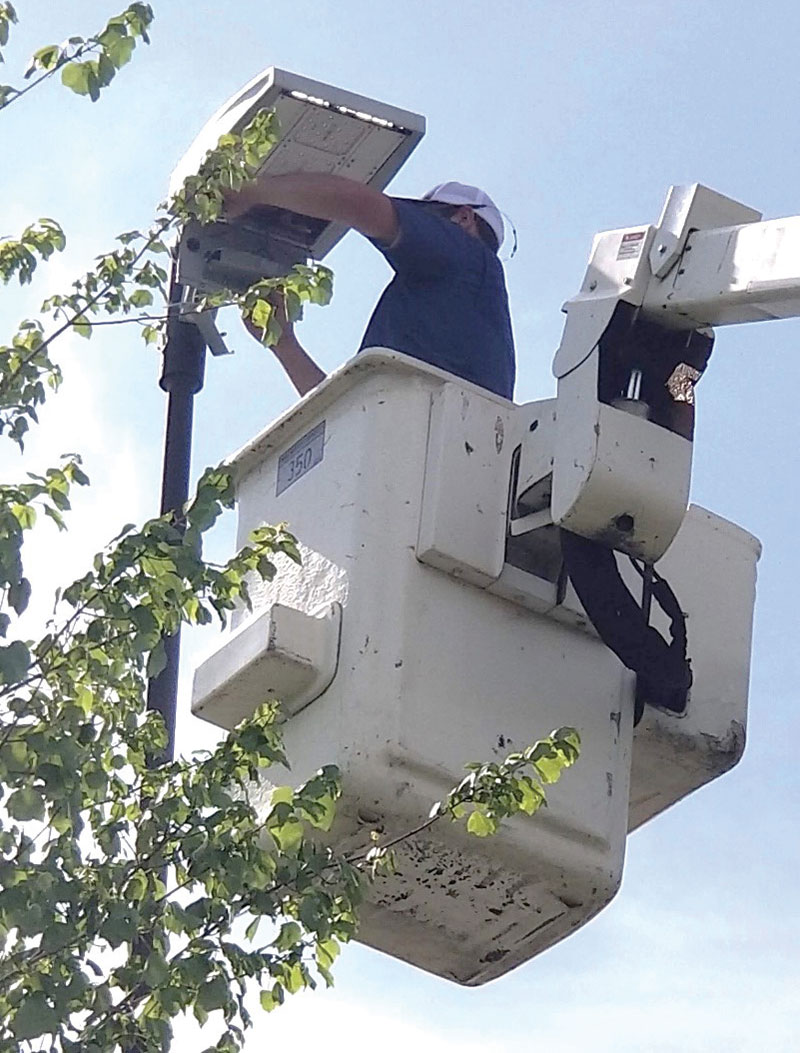An unfiltered look at connected parking lot lighting systems
By Ruth Taylor

The Next Generation Lighting Systems (NGLS) program has launched the first phase of its outdoor lighting evaluations, installing six connected lighting systems in parking lots at Virginia Tech Transportation Institute (VTTI) and beginning an evaluation process that will continue for the next two years. A number of lighting professionals gave up their summer evenings for the sake of a higher cause: finding out not only how easy connected parking lot systems are to install and configure, but also what happens when you add occupancy sensors. We want to know, for example, whether presence detection affects installation and configuration, and whether currently available sensors work in typical retrofit conditions. And we also want to know what owners, architects and lighting designers want from such systems—and whether presence detection in the real world actually saves energy.
Installed on individual parking lots at VTTI at a pole height of 30 ft with the poles spaced 100 to 150 ft apart, the six systems replaced 58 luminaires on nearly 350,000 sq ft of space to create a “living lab” where evaluations could be conducted in a real-world setting.
The control systems included LightGRID (Current by GE), SimplySNAP (Synapse), wiSCAPE (Hubbell Control Solutions), NearSky (Cimcon Lighting), Limelight (Lutron) and DTL DSN (Acuity Brands). In terms of technology and design, the wireless control systems used a variety of technologies and approaches that featured wired (Ethernet) and wireless (cellular) gateways, remote and fixture-integrated sensor mounting, and passive infrared (PIR) and microwave radar sensors.
Based on observations, measurements and detailed notes made during installation, configuration and operation, the team drew three overall conclusions from this initial phase of the evaluation:
- Installation and configuration were challenging.
- Once installed and configured, basic wireless control systems generally functioned reasonably well.
- Presence detection by sensors was very disappointing.
Installation and Configuration. Overall, we were challenged by both the complexity of the systems and the level of manufacturer support needed for their installation and configuration. System installation and configuration ranged from reasonably successful to outright failure. While it should be noted that several of the systems were new and not on the market yet, all six systems had configuration issues, as well as issues with either wiring or programming the sensors. Two systems required replacement of failed hardware, and two had problems with gateway communications.
All six systems were found to be problem-free as far as scheduling was concerned. Four of the systems dimmed adequately by the time performance was formally evaluated, although only two did so at initial start-up. However, many of the systems required multiple electrical contractor callbacks, which included multiple rides in a bucket truck to reach the luminaires and get the systems working—potentially adding considerable time and expense for building owners.
Configuration of the sensors (as distinct from the central control functionality of scheduling and dimming) was a major challenge (see below). In fact, the majority of installation and configuration issues we encountered related to presence-detection hardware. The sensors and their nodes didn’t always work together, and system integration was typically problematic.
Another thing we learned was that information provided to the installation and configuration (IC) supervisor doesn’t always make it to the “boots on the ground.” Even when the information is there, much of the time it’s not carefully read—especially when it comes to seemingly familiar tasks, such as installing and wiring a luminaire. Moreover, things still end up getting installed incorrectly when instructions are read, if those instructions aren’t clear.
Troubleshooting today’s control systems is now essentially like troubleshooting a computer—a complex process. One installer voiced concern that if he encounters issues with a system, he won’t be able to go to his local electrical distributor for spare parts to fix things, which can be especially troublesome when the resulting delay involves a dark nighttime parking lot that creates safety concerns.
Wireless Control. Overall, we found that once installed and fully commissioned, the control systems worked for the most part, doing a good job of scheduling, dimming, monitoring and reporting.
Presence Detection. We were especially disappointed to find that none of the six presence-detection systems we tested performed successfully. As noted above, initial start-up was an issue with most of the systems. There were wiring issues and false triggering, and occupancy groups were either not configured or weren’t saving correctly. In some cases, sensitivity levels weren’t set correctly.
Although we found presence detection to be a major problem, it was sometimes difficult to tell from sensor performance whether this was due to an improper setting or an equipment issue. All six systems had issues with occupancy sensitivity or latency; again, it was often difficult to tell which issue was the culprit. Only one system had fully functioning occupancy sensors at start-up, and none of the systems showed reliable, consistent presence detection during the performance evaluations.
Infrared technology appears to have significant limitations in outdoor applications, and issues related to latency, sensitivity and coverage are intertwined, which creates a “perfect storm.”
WHILE ALL WORKING SYSTEMS successfully provided monitoring capabilities, the user interfaces could use improvements in order to meet users’ actual needs, especially in the case of more-advanced users who need more engineering data or detailed status indications. And it’s clear that in order to ensure that these systems continue to work properly, manufacturer support is not only necessary, it’s critical—as it is throughout installation and configuration.
Perhaps our most significant finding was the poor performance of the passive infrared sensors installed on-site. Industry has an important challenge and opportunity to bring presence detection technology up to the demands of current energy codes and environmental imperatives. Of course, this is a challenge that faces the design community as well.
The NGLS outdoor evaluations are far from over; they’ll continue, with user assessments as well as more-detailed performance analysis and more-controlled sensor studies. So stay tuned for more results.
Author’s Note:
A shout-out is in order for the manufacturers who donated equipment and braved the rigors of an NGLS evaluation in the interest of improving their products. Co-sponsored by IES, the U.S. Department of Energy and the International Association of Lighting Designers, NGLS evaluates today’s connected lighting systems in real-world installations, in order to identify challenges in installation and operation, reveal needed product improvements, and articulate principles and best practices that will reduce configuration complexity and enable system performance to meet expectations.


